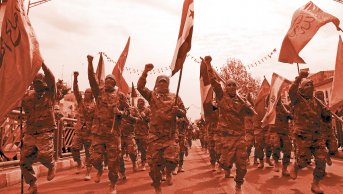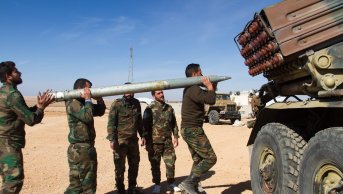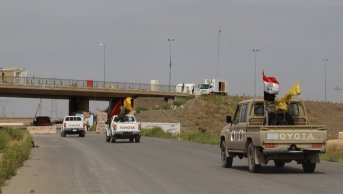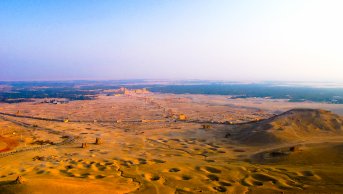How much threat do the Iran-backed militias in Syria pose to Turkey?
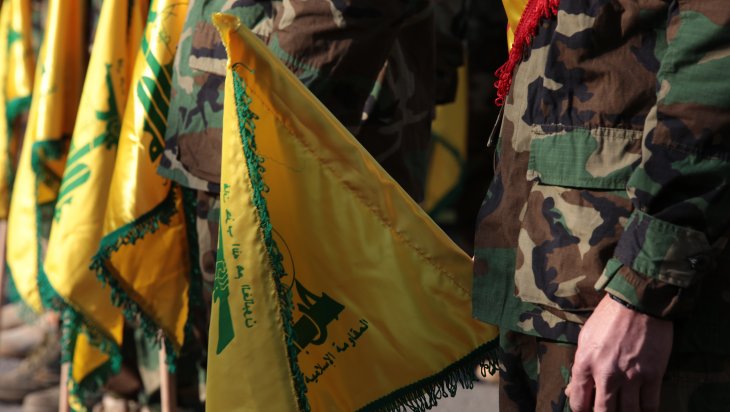
The strongest reaction to Turkey giving signals of an operation against PKK elements in Sinjar and its surroundings came from the Iran-backed sectarian militias in the region. Threat messages by Harakat Hezbollah Al-Nujaba and Asa'ib Ahl al-Haq pointed to the problems Turkey may face in case it engages in military operations in northern Iraq. However, it is not enough to interpret this development as limited to Iraq. The sectarian militias Iran protects and supports in Syria and in Iraq threatens Turkey’s role in both countries and the stability of the region.
In the Turkey-backed Syrian opposition forces fight against the regime elements on the field, the Iran-backed militias that make up the backbone of the regime’s defensive and offensive power, especially took a very active role on the front line in Aleppo and Idlib. The siege strategy used by the Syrian regime and its supporters to control the opposition regions was first experienced in Al-Qusayr in Southern Syria, and its implementer was Hezbollah, one of Iran's significant allies in the region. Iran-backed militias played a practical role in the violent siege trials in the following years as well. The National Defense Forces, Liwa Fatemiyoun, Liwa Zaynebiyoun, Hezbollah, Local Defense Forces, and many Iraqi militias were at the forefront during the regime’s advance in the countryside of Aleppo and the subsequent bloody siege of Aleppo. The Iranian Revolutionary Guards elements were active under the command of these various militia groups on the ground and the images of Qasem Soleimani coming to the Aleppo countryside to control these militia forces were disseminated by Iran to send a message to all parties.
Being the implementer of the regime’s besiege-evacuate-depopulate strategy, the Iran-backed militias repeatedly came to the fore with hostile actions against Turkey. In the night of July 15, when the coup attempt occurred in Turkey, Iran-backed militias celebrated the event on social media and labelled the Syrian opposition elements that they call their enemies as Turkey-backed terrorists, which overall constitutes examples for the stance the Iran-backed militias adopted towards Turkey. Upon Iran not managing to take a seat on the table during the Russia-Turkey reconciliation for the Aleppo evacuation, the said militias conducted provocative actions and attacked the evacuation convoy. These threatening attitudes evolved into direct conflict following the establishment of observation points in Idlib and the Operation Olive Branch. On its way to establish a military observation point in Al-Eis in western rural Aleppo, a Turkish convoy was attacked by Iran-backed militias and a Turkish soldier was martyred. In the following period, Iran-backed militias deployed in Nubl and Zahra tried to reach the center of Afrin by convoys in order to support YPG elements in the city, and yet, dozens of them were neutralized by Turkish airstrikes.
The Operation Spring Shield which was carried out in Spring 2020 was the largest military event during which Turkey directly confronted with the Iran-backed militias. Targeted by the Turkish Armed Forces by unmanned aerial vehicles and artillery guns, the Iran-backed militias suffered hundreds of casualties of dead and wounded within a few days. While Hezbollah and Liwa Zaynebiyoun were the most heavily targeted groups, capitalizing directly on the militias showed how far Iran could go to prevent Turkey in Idlib.
Combatting YPG and ISIS elements in Syria and being among the most efficient actors in the fight against these forces in the region, Turkey may have to wage a similar war against the Iran-backed sectarian militias in both Iraq and Syria. When we examine the Iran-backed militias in Syria, it is likely that Turkey confronts these forces on a broad front line. Idlib, Aleppo countryside and some regions under YPG control may come to the forefront as the major conflict zones, where Turkey may have to struggle. Given the cooperation between YPG and the regime against Turkey and Iran’s contact with local elements, thanks to its militialization process, it does not seem very likely for the sectarian militias to face serious problems in the short term in terms of logistics and human resources in case a conflict arises.
The growing capacity and rising visibility of sectarian militias are also a threat to other actors and stability in the region. As the army of the Assad regime, which lost its characteristics of being a modern army as a result of the heavy damage it suffered, could not provide security, Russia and Iran came to the region and joined the conflict with both their own forces and proxy forces they supported. As a result of the devastating process the Syrian economy went through, “militialization” emerged as an ever-rising trend with the support of Moscow and Tehran. While this process makes the fragmented form of security elements in the field inextricable, it also means a Syria in which undisciplined actors who are difficult to control have more say.
In the initial years of the war, various actors, especially Israel, emphasised Hezbollah's involvement in the Syrian crisis and its military presence in the region. As of 2021, dozens of various militia groups, which may be considered in the same group along with Hezbollah due to their ideological background and political engagement, are fighting in the ranks of the regime under Iranian support in a wide geography from Idlib to Al-Suwayda, from Quneitra to Deir ez-Zor. Tehran is in competition with Russia on the Dera-Homs line through Shiite militias and the regime army. Iran increases its influence on local actors, including some Druze elements in Quneitra and Al-Suwayda, and poses a threat to both Jordan and Israel. Using these threats as an excuse, Israel occasionally organizes airstrikes against Iranian targets in Syria.
Although they are seen to be balancing YPG-SDF elements in the eastern parts of Syria in the first place, Iran-backed militias are highly likely to cause medium and long-term problems in this line. Carrying out both ideological and religious activities through institutions and militias in Deir ez-Zor as in the capital Damascus, Tehran continues its initiatives that threaten the demographic structure of the region. Nevertheless, it is worth noting that, it has not achieved a significant change yet. Given the diversity of external actors in Syria and the far less adequate regime army compared to Iraq, the fact that the Iranian-backed militias in Iraq are in contact with Syria's western and northern borders with almost no logistical interruptions could lead to a wave of violence that is difficult to control.
Although the aforementioned threats lead to the emergence of a pessimistic atmosphere, opportunities for cooperation may arise. Joint defense and cooperation relations can be established with actors, especially the United States, who see Iran-backed militias as a threat. Actors that have disagreements over YPG-centered debates and appear to be in a dead-end may meet on the common ground due to the threat of Iran-backed militias. However, this will require all parties to update their short and medium-term threat rankings first. Given the strengthening of YPG-PKK threat and the Iranian-backed militias, Turkey may pursue a new strategy. For this strategy to make sense, the approach of the Biden administration regarding the Iran-backed military presence in the region needs to be clarified. Otherwise, developments such as the US airstrikes in March will not go beyond the moves that strengthen the Iran-backed militias' discourse over anti-Americanism but do not cause a critical change in the field.

